|
|
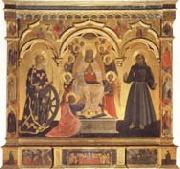 |
Andrea Di Giusto
|
|
b Florence, c. 1400; d Florence, 2 Sept 1450
Italian painter. He was an eclectic minor Florentine master who was influenced by, and at different times imitated, the styles of Masaccio, Masolino, Lorenzo Monaco, Fra Angelico and Domenico Veneziano. In 1426 he was an assistant of Masaccio in the execution of the altarpiece for the Carmine church in Pisa (London N.G.; Naples, Capodimonte; Berlin, Gem?ldegal.; Malibu, CA, Getty Mus.; Pisa, Mus. N. & Civ. S Matteo) and painted its predella panels of the Legend of St Julian and the Charity of St Nicholas (Berlin, Gem?ldegal.). His name appears in the tax registers of the Florentine Archivio delle Decime from 1427 to 1447 and in the protocols of the Arte della Calimala in 1436, the same year in which he received 60 florins for an altarpiece (destr.) for S Lucia dei Magnoli. In 1437 he signed and dated the Assumption of the Virgin with SS Catherine and Francis (Florence, Accad.). His other dated works are a Virgin and Child with Four Saints (1435; Prato, Mus. Com.), which is a copy of Lorenzo Monaco's Monte Oliveto Altarpiece of 1410 (Florence, Pal. Davanzati); a Virgin and Child (1435; Florence, Villa I Tatti), a rustic interpretation of a Virgin and Child by Fra Angelico (Turin, Gal. Sabauda) |
|
|
|
|
|
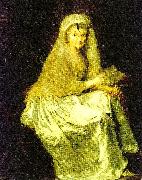 |
anna dorothea lisiewska therbusch
|
|
Lisiewski, Anna Dorothea (von) / Lisiewska-Therbusch, Anna Dorothea / Liszeswka, Anna Dorothea.
Anna Dorothea Therbusch (somtetimes Anna Dorothea Therbusch-Lisiewska, or Lisiervska/Lisziewska/Liesiewka (1721-1782) was a German painter.
|
|
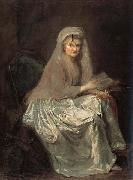 |
anna dorothea therbusch
|
|
1721-82
German painter of Polish descent. She was taught by her father, the portrait painter Georg Lisiewski (1674-1751), and received further training from Antoine Pesne in Paris. She worked for Charles-Eugene, Count of W?rttemberg, in Stuttgart from 1761 to 1762, and for Charles Theodore Wittelsbach, Elector Palatine of the Rhine, in Mannheim from 1763 to 1764. In 1765 she returned, via Stuttgart and Hohenzollern-Hechingen, to Paris, where in 1767 she became a member of the Academie Royale. She met Denis Diderot and Philipp Hackert, both of whom she painted, and Charles-Nicolas Cochin , but, despite consistent support from Prince Galitsyn, she was unable to establish herself in Paris. In 1769 she returned to Berlin where she received commissions for mythological paintings (e.g. Diana and her Nymphs, 1771; Potsdam, Neues Pal.) from Frederick II, King of Prussia. She painted portraits of members of the Prussian court, and the Berlin bourgeoisie, and in 1773 was commissioned by Catherine II, Empress of Russia, to paint a portrait of the Prussian royal family. |
|
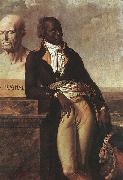 |
Anne-Louis Girodet de Roussy-Trioson
|
|
(also given as Anne-Louis Girodet de Roucy-Triosson, Anne-Louis Girodet-Trioson) January 5, 1767 - December 9, 1824), was a French painter and pupil of Jacques-Louis David, who was part of the beginning of the Romantic movement by adding elements of eroticism through his paintings. Girodet is remembered for his precise and clear style and for his paintings of members of the Napoleonic family.
|
|
|
|
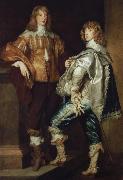 |
anthonis van dyck
|
|
Flemish painter and draughtsman, active also in Italy and England. He was the leading Flemish painter after Rubens in the first half of the 17th century and in the 18th century was often considered no less than his match. A number of van Dyck's studies in oil of characterful heads were included in Rubens's estate inventory in 1640, where they were distinguished neither in quality nor in purpose from those stocked by the older master. Although frustrated as a designer of tapestry and, with an almost solitary exception, as a deviser of palatial decoration, van Dyck succeeded brilliantly as an etcher. He was also skilled at organizing reproductive engravers in Antwerp to publish his works, in particular The Iconography (c. 1632-44), comprising scores of contemporary etched and engraved portraits, eventually numbering 100, by which election he revived the Renaissance tradition of promoting images of uomini illustri. His fame as a portrait painter in the cities of the southern Netherlands, as well as in London, Genoa, Rome and Palermo, has never been outshone; and from at least the early 18th century his full-length portraits were especially prized in Genoese, British and Flemish houses, where they were appreciated as much for their own sake as for the identities and families of the sitters.
|
|
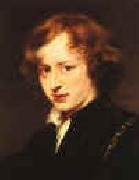 |
Anthony Van Dyck
|
|
Dutch
1599-1641
Anthony Van Dyck Locations
Flemish painter and draughtsman, active also in Italy and England. He was the leading Flemish painter after Rubens in the first half of the 17th century and in the 18th century was often considered no less than his match. A number of van Dyck studies in oil of characterful heads were included in Rubens estate inventory in 1640, where they were distinguished neither in quality nor in purpose from those stocked by the older master. Although frustrated as a designer of tapestry and, with an almost solitary exception, as a deviser of palatial decoration, van Dyck succeeded brilliantly as an etcher. He was also skilled at organizing reproductive engravers in Antwerp to publish his works, in particular The Iconography (c. 1632-44), comprising scores of contemporary etched and engraved portraits, eventually numbering 100, by which election he revived the Renaissance tradition of promoting images of uomini illustri. His fame as a portrait painter in the cities of the southern Netherlands, as well as in London, Genoa, Rome and Palermo, has never been outshone; and from at least the early 18th century his full-length portraits were especially prized in Genoese, British and Flemish houses, where they were appreciated as much for their own sake as for the identities and families of the sitters. |
|
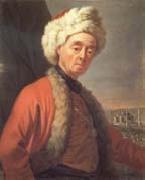 |
Antoine de Favray
|
|
French, 1706-died circa 1791,French painter. He is not documented until 1738, when he was mentioned as a private pupil of Jean-Fran?ois de Troy (ii), who was then director of the Acad?mie de France in Rome; in 1739 he became an official student at the Acad?mie. Among his student works is a copy (untraced) of Raphael's Fire in the Borgo (Rome, Vatican, Stanza dell'Incendio), which was mentioned by Charles de Brosses and exhibited in Paris in 1741. In 1744, for reasons that are not clear, he left Rome for Malta, remaining there for much of the rest of his career and devoting himself primarily to portraiture and genre painting. His ambition as a history painter, however, was fulfilled to a certain extent as a result of the patronage of two Grand Masters of the Order of the Knights of Malta, Manoel Pinto da Fonseca and Emmanuel de Rohan. His first dated picture executed in Malta is a Portrait of a Maltese Lady (1745; Paris, Louvre). |
|
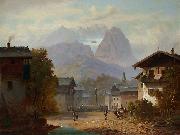 |
Anton Doll
|
|
painted Ansicht von Garmisch in 19th century
|
|
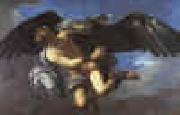 |
Anton Domenico Gabbiani
|
|
1652-1726
Italian
Anton Domenico Gabbiani Gallery
Italian painter. He first trained with the Medici court portrait painter Giusto Suttermans and then with the painter Vincenzo Dandini. On 20 May 1673 he arrived in Rome, where he studied for three years under Ciro Ferri and Ercole Ferrata at the Accademia Fiorentina. He responded in particular to the paintings of Pietro da Cortona and Carlo Maratti who were both to be important influences on him. Though not precocious, Gabbiani became one of the most noted painters from the Accademia. After a period in Venice (1678-9) with the portrait painter Sebastiano Bombelli, he was in Florence in 1680. By 1684, the year in which he executed an Annunciation (destr.) for the Palazzo Pitti, he was an independent painter. His first important public commission, the St Francis de Sales in Glory (1685) for the church of SS Apostoli, Florence (in situ), shows the influence of Maratti in its grandiose composition and that of Dandini in the treatment of figures. In Prince Ferdinando de Medici Gabbiani found a particularly loyal patron, and he painted his portrait, Ferdinando de Medici and his Musicians (c. 1685; Florence, Pitti). One of the works executed for Ferdinando was possibly a portrait of his sister, which Chiarini has identified with the painting of Anna Maria Luisa de Medici (c. 1685; Florence, Pitti). Further works from this period are the group portrait of Three Musicians (Florence, Pitti) at Ferdinando court and a Group of Courtiers (1685-90; Florence, Uffizi). |
|
|
|
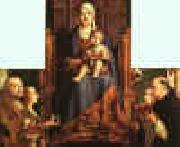 |
Antonello da Messina
|
|
1430-1479
Italian
Antonello da Messina Galleries
Antonello was born at Messina around 1429-1431, to Giovanni de Antonio Mazonus and Garita (Margherita). He was probably apprenticed in his native city and in Palermo.
Around the year 1450, according to a 1524 letter of the Neapolitan humanist Pietro Summonte,[1] he was a pupil of the painter Niccol?? Colantonio at Naples, then one of the most active centres of Renaissance arts.
Around 1455 he painted the so-called Sibiu Crucifixion, which was inspired by the Flemish Calvaries and is housed in the Muzeul de Art?? in Bucharest. Of the same years is the Crucifixion in the Royal Museum of Antwerp: his early works shows a marked Flemish influence, which it is now understood he derived from his master Colantonio and from works by Rogier van der Weyden and Jan van Eyck that belonged to Colantonio's patron, Alfonso V of Aragon; his biographer Vasari remarked that Antonello saw at Naples an oil painting by Jan Van Eyck (the "Lomellini Tryptych") belonging to King Alphonso of Aragon; Vasari's further narrative, that being struck by the new method, set out for The Netherlands to acquire a knowledge of the process from Van Eyck's disciples is discredited today. Another theory, supported only by vague documentary evidence, suggests that in 1456 Antonello visited Milan, where he might have met Van Eyck's most accomplished follower, Petrus Christus. Since Antonello was one of the first Italians to master Eyckian oil painting, and Christus was the first Netherlandish painter to learn Italian linear perspective, their meeting is a tempting answer to both questions. But in fact, neither artist is known for certain to have been in Milan at the time.
The following year, Antonello received his first commission as an independent artist, a banner for the Confraternit?? di San Michele dei Gerbini in Reggio Calabria. At this date, he was already married, and his son Jacobello had been born.
In 1460, his father is mentioned leasing a brigantine to bring back Antonello and his family from Amaltea, a town in Calabria. In that year, Antonello painted the so-called Salting Madonna, in which standard iconography and Flemish style are backed by a greater attention in the volumetric proportions of the figures, probably coming from his knowledge of some works by Piero della Francesca. Also from around 1460 are the two small panels depicting Abraham Served by the Angels and St. Jerome Penitent now in the Museo Nazionale della Magna Grecia in Reggio Calabria. In 1461 his younger brother Giordano entered Antonello's workshop, signing a three-years' contract. Of that year is a Madonna with Child for the Messinese nobleman Giovanni Mirulla, now lost.
Between 1465-1470, Antonello finished a Portrait of a Man now at Cefal??. His portraits are noteworthy for his characteristic use of the three-quarter view, typical of the Flemish School, whereas almost all Italian painters adopted the medal profile pose. Antonello travelled to Venice around 1470, to see Giovanni Bellini's paintings.
The Palermo Annunciation.In this year he executed his first signed and dated work, the Salvator Mundi. Back at Sicily, Antonello finished the St. Gregory's Polyptych.
In 1474, he painted the Annunciation, now in Syracuse, and the St. Jerome in His Study, one of his most famous paintings. The following year he began his regular sojourn in Venice, where he remained until the fall of 1476. His works of this period begin to show a greater attention to the human figure, regarding both anatomy and expressivity, according to the influence of Piero della Francesca and Bellini.
His most famous pictures dating from this period include the Condottiero (Louvre, illustration), the San Cassiano Altarpiece and the St. Sebastian (see selected works for details). The San Cassiano Altarpiece was especially influential on Venetian painters, as it was one of the first of the large compositions in the sacra conversazione format which was perfected by Giovanni Bellini (Antonello's surviving work in Vienna is only a fragment of the much larger original).
Antonello returned briefly to Sicily in 1476, where he painted the famous Virgin Annunciate, now in the Palazzo Abatellis at Palermo.
He died at Messina in 1479: his testament dates from February of that year, and he is documented as no longer alive two months later. Some of his last works remained unfinished, but were completed by his son Jacobello. |
|
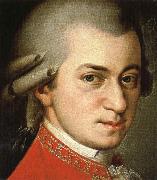 |
antonin dvorak
|
|
Named after Prince Antoni Radziwiłł, who built a wooden summer residence here between 1822 and 1824 for his family. The Radziwiłł family played an important role in Polish?CLithuanian history over several centuries and owned lands larger than the state of Belgium. |
|
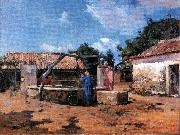 |
Antonio Carvalho de Silva Porto
|
|
(Porto, 11 November 1850 - Porto, 11 June 1893) was a Portuguese naturalist painter.
Born in Porto, he studied there under João Antenio Correia and T. Furtado, then continued his studies in Paris and Rome.
While in Paris he exhibited his work in the Salon and in the World´s Fair of 1878. In Paris, he studied with his friend João Marques de Oliveira, where they were pupils of Adolphe Yvon and Alexandre Cabanel. They became followers of the naturalist Barbizon School, and brought the new school of painting to Portugal, when they returned in 1879.
Silva Porto become one of the most acclaimed naturalist painters of his generation, showing the heritage of Jean-Baptiste Camille Corot and Charles-François Daubigny. Secondary effects from impressionism can sometimes be found in his paintings.
|
|
|
|
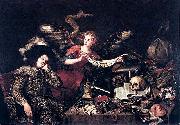 |
Antonio de Pereda
|
|
(ca. 1611-1678) was a Spanish Baroque-era painter , best known for his still lifes. Pereda was born in Valladolid. He was the eldest of three brothers from an artistic family. His father, mother and two brothers were all painters. He was educated in Madrid by Pedro de las Cuevas and was taken under the protective wing of the influential Giovanni Battista Crescenzi.After Crescenzi's death in 1635, Pereda was expelled from the court and began to take commissions from religious institutions. As well as still lifes and religious paintings, Pereda was known for his historical paintings such as the Relief of Genoa (1635) which was painted for the Buen Retiro Palace in Madrid as part of the same series as Velezquez's Surrender of Breda.
|
|
|
|
|
|
|
|
|
|
Apollonio di Giovanni
|
|
ca.1415-1465
Italian painter and illuminator. He was trained by illuminators in the circle of Bartolomeo di Fruosino and Battista di Biagio Sanguini (1393?C1451) and became a member of the Arte dei Medici e degli Speziali in 1442 and of the Compania di S Luca in 1443. Apollonio was influenced by Filippo Lippi, Lorenzo Ghiberti and Paolo Uccello. |
|
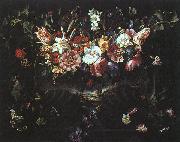 |
Arellano, Juan de
|
|
Spanish Baroque Era Painter, 1614-1676
Spanish painter. He was the pre-eminent painter of flower-pieces in 17th-century Spain. Although Spaniards of the previous generation had painted such works, it was the inspiration of Flemish and Italian examples in Madrid that from c. 1650 encouraged Arellano's success as a specialist in this genre. According to Palomino, who moved to the Court shortly after the artist's death and befriended many painters who had known him, Arellano began to paint flowers only in his thirties after a beginning that showed little promise. |
|
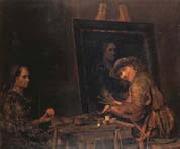 |
Arent De Gelder
|
|
1645-1727
was one of Rembrandt's last pupils while in Amsterdam, studying in his studio from 1661 to 1663. He was not only one of the most talented of Rembrandt's pupils, but also one of his most devoted followers, for he was the only Dutch artist to paint in the tradition of Rembrandt's late style into the 18th century. |
|
|
|
|
|
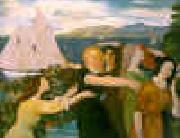 |
Arthur Bowen Davies
|
|
1862-1928
Arthur Bowen Davies Gallery
Arthur Bowen Davies (September 26, 1863 ?C October 24, 1928) was an avant-garde American artist.
He was born in Utica, New York and studied at the Chicago Academy of Design from 1879 to 1882. He briefly attended the Art Institute of Chicago and then moved to New York City where he studied at the Art Students League.
Davies was a principal organizer of the 1913 Armory Show and was a member of The Eight, a group of painters including five associated with the Ashcan school: William Glackens (1870-1938), Robert Henri (1865-1929), George Luks (1867-1933), Everett Shinn (1876-1953) and John French Sloan (1871-1951), along with Arthur B. Davies (1862-1928), Ernest Lawson (1873-1939) and Maurice Prendergast (1859-1924). Davies is best known for his ethereal figure paintings. He worked as a billboard painter, engineering draftsman, and magazine illustrator. |
|
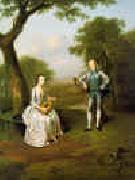 |
Arthur Devis
|
|
1712-1787
English
By 1728 he had left Preston, and the following year he was working in London for the Flemish topographical and sporting painter Peter Tillemans. There he specialized in landscape painting and copying various works in Tillemans studio after Marco Ricci, Giovanni Paolo Panini and Jan van Bloemen. Devis earliest known commission, Hoghton Towers from Duxon Hill, Lancashire (1735; priv. col., see 1983 exh. cat., no. 3), painted for Sir Henry Hoghton during a trip to Preston in 1734-5, shows Tillemans influence in its attention to detail and the use of thin, transparent paint. Thomas Lister with his Family (c. 1738; Chicago, IL, A. Inst.) demonstrates a similar interest in landscape, featuring the family group in Gisburn Park, Lancs. Devis had returned to London by 1742 and established himself as a painter of conversation pieces, with a studio in Great Queen Street. Roger Hesketh with his Family is typical of his work at this time; it shows how Devis transformed the intimacy of a Dutch 17th-century genre scene into an elegant interior with the group of sitters connected by formal, schematic gestures. Roger Hesketh stands apart, in a tastefully contrived pose, his legs crossed and right arm thrust inside his waistcoat. His son, Fleetwood, stands with his hand resting on a dog next to his wife, who is seated with an infant on her lap. The adjacent telescope, globe and marine paintings are intended to advertise Hesketh interest in astronomy and travel. |
|
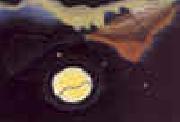 |
Arthur Dove
|
|
American
1880-1946
Dove returned to America in 1909 and met Alfred Stieglitz. Stieglitz, the eldest child of a New York rich family and was send to study in Germany at the age of 16 where he was overtaken with the passion of photography. In 1905 he returned to New York with 15 years of experience he was at the front lines to make photography respected as one of the fine art. Alfred Stieglitz was a well known photographer and gallery owner who was very active in promoting modern art in America. In his attempt to educate the art public, he started to introduce other art besides photography. Along with American modernists he would show European work. These pieces had never been seen in the United States.[1] Stieglitz was a New York art world celebrity.[1] Dove made the decision to quit his career as an illustrator but was in need of artistic identity along with emotional bolstering and Stieglitz filled both.[5] The photographer was 61, 16 years younger than Dove and with Anglo-Saxon heritage, being Protestant with a small town background was in contrast to Stieglitz??s experience being urban, Jewish and rooted in European culture. Dove was gentle, quite, and a good friend while Stieglitz was argumentative and shrewd. They both had in common that they believed art forms should embody modern spiritual values not materialism and tradition. Stieglitz was later the husband of the famed painter Georgia O??Keeffe. With Stiegliz??s support, Dove produced what are known as the first purely abstract paintings to come out of America. Dove exhibited his works at Stieglitz??s ??291?? gallery in 1910 and in 1912 when he had his first one-man exhibition. The 1910 show ??Younger American Painters?? put Dove in the company of his old friend Maurer. Dove showed one painting, a large still life painted in France ??The Lobster??, which would be his last representational work. The 1912 show at the ??291??, Doves only one man showed a group of pastels that came to be know as ??Ten Commandments??, would be the first public display of nonillusionistic art by an American. In the two years since meeting Stieglitz Dove found himself as a leader in international art developments. From 1912 to 1946 Dove showed his work yearly at Stieglitz??s galleries, ??291??, ??intimate Gallery?? and ??An American Place.?? Dove??s works were based in natural forms and he referred to his form of abstraction as ??extraction,?? in essence, extracting the essential forms of a scene from a nature. |
|
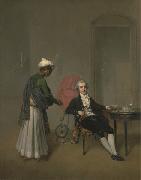 |
Arthur William Devis
|
|
(10 August 1762 - 11 February 1822) was an English painter of history paintings and portraits. He was appointed draughtsman in a voyage projected by the East India Company in 1783, under Captain Henry Wilson, in which he was wrecked on the Pelew Islands before proceeding to Canton and thence to Bengal. He painted portraits and historical subjects, sixty-five of which he exhibited (1779-1821) at the Royal Academy.
|
|
|
|
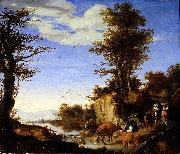 |
Ary de Vois
|
|
was a Dutch Golden Age painter.
Ary de Vois was the son of Alewijn de Vois from Utrecht, who was organist in the Pieterskerk, Leiden, in 1635. Ary became a pupil in Utrecht of Nikolaus Knepfer, who also taught Jan Steen. Ary then returned to Leiden to study with Abraham van den Tempel, who lived there between 1648 and 1660. De Vois joined the Leiden Guild of St Luke on 16 October 1653, paying dues until 1677. He was dean in 1662-64, headman in 1664-65 and dean again from 1667-68. He married Maria van der Vecht, on 5 February 1656.
According to Houbraken his marriage caused a lull in his production, especially when he moved to Warmond where he took up fishing as a hobby. He had to move back to Leiden in order to keep his production levels high
|
|
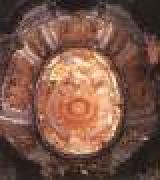 |
ASAM, Cosmas Damian
|
|
German Baroque Era Sculptor, 1686-1739
Bavarian architects and decorators. After studying in Rome (1711 ?C 13), Cosmas Damian became a prolific fresco painter, and his brother, Egid Quirin, became a sculptor and stuccoist. They developed the effects of dramatic lighting and illusionism originated by Gian Lorenzo Bernini and Andrea Pozzo. Working as a team, they produced magnificent illusionistic decoration in ecclesiastical buildings, combining dramatic lighting and colour. Their works are notable for their profound and dramatic intensity of religious feeling. The brothers became the principal late Baroque exponents of illusionist decoration in religious architecture. Their most notable collaboration is the church of St. John Nepomuk in Munich (1733 ?C 46) ?? known as the Asamkirche in honour of the brothers. |
|
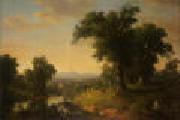 |
Asher Brown Durand
|
|
1796-1886
Asher Brown Durand Galleries
His interest shifted from engraving to oil painting around 1830 with the encouragement of his patron, Luman Reed. In 1837, he accompanied his friend Thomas Cole on a sketching expedition to Schroon Lake in the Adirondacks and soon after he began to concentrate on landscape painting. He spent summers sketching in the Catskills, Adirondacks, and the White Mountains of New Hampshire, making hundreds of drawings and oil sketches that were later incorporated into finished academy pieces which helped to define the Hudson River School.
Durand is particularly remembered for his detailed portrayals of trees, rocks, and foliage. He was an advocate for drawing directly from nature with as much realism as possible. Durand wrote, "Let [the artist] scrupulously accept whatever [nature] presents him until he shall, in a degree, have become intimate with her infinity...never let him profane her sacredness by a willful departure from truth."
Like other Hudson River School artists, Durand also believed that nature was an ineffable manifestation of God. He expressed this sentiment and his general views on art in his "Letters on Landscape Painting" in The Crayon, a mid-19th century New York art periodical. Wrote Durand, "[T]he true province of Landscape Art is the representation of the work of God in the visible creation..."
Durand is noted for his 1849 painting Kindred Spirits which shows fellow Hudson River School artist Thomas Cole and poet William Cullen Bryant in a Catskills landscape. This was painted as a tribute to Cole upon his death in 1848. The painting, donated by Bryant's daughter Julia to the New York Public Library in 1904, was sold by the library through Sotheby's at an auction in May 2005 to Alice Walton for a purported $35 million. The sale was conducted as a sealed, first bid auction, so the actual sales price is not known. At $35 million, however, it would be a record price paid for an American painting at the time. |
|
 |
AST, Balthasar van der
|
|
Dutch Baroque Era Painter, ca.1593-1656
1657). Dutch painter. He was the brother-in-law of Ambrosius Bosschaert (i), whose household he entered in 1609, after the death of his father. He remained as Bosschaert's pupil, until he was 21. In 1615 van der Ast moved with the Bosschaert family to Bergen-op-Zoom. However, a year later the Bosschaerts were living in Utrecht, but van der Ast is not recorded there until 1619, when he was entered as a master in the Guild of St Luke. He remained in Utrecht until 1632, then lived in Delft, where he enrolled in the painters' guild on 22 June 1632. On 26 February 1633 he married Margrieta Jans van Bueren in Delft, where he spent the rest of his career; the marriage produced two children. |
|
|
|
|
|
|
|
|
|
|
|
|
|
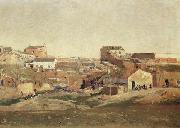 |
Aureliano De Beruete Y Moret
|
|
Spanish , Madrid, 1845 - Madrid, 1912
Spanish writer, painter and collector. After pursuing a political career and taking a doctorate in civil and canon law, he dedicated himself to writing on art and produced important studies on Diego Velezquez (1898), Joaqu'n Sorolla y Bastida (1901) and other artists. He travelled extensively and enthusiastically in Europe (France, Belgium, Switzerland, the Netherlands, Italy, Germany, England and elsewhere), studying especially the different national schools of painting. On his travels he also painted landscapes. After working for some time as a copyist in the Museo del Prado, Beruete decided in 1873 to concentrate his efforts on painting and on learning to perfect his craft. He enrolled at the Escuela Superior de Bellas Artes de S Fernando in Madrid and also studied at the studio of Carlos de Haes. Beruete was among the founders of the Instituci'n Libre de Enseeanza, and with its members, and with Carlos de Haes, he made several study trips abroad. In Paris he came to know the painting of the Barbizon school, and in Belgium he assimilated the teaching of the generation of landscape artists who had adopted a form of Realism. |
|
|
|
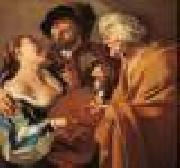 |
BABUREN, Dirck van
|
|
Dutch Baroque Era Painter, 1595-1624
1624). Dutch painter. His father, Jasper van Baburen (d ?1599), had been in the service of Geertruijd van Bronckhorst van Battenburg, Baroness (vrijvrouw) of Vianen, Viscountess (burggravin) of Utrecht, and thus Dirck must have received a better than average education, a fact at least partially confirmed by the innovative and often literary nature of his subject-matter. In 1611 he is recorded as a pupil of the portrait and history painter Paulus Moreelse in Utrecht. It is likely that this was the last year of his apprenticeship. Van Baburen probably left for Italy shortly after 1611, for a document rediscovered in the late 1980s records a signed and dated altarpiece of the Martyrdom of St Sebastian (1615; untraced), executed for a church in Parma. His most important pictures made in Italy were painted in collaboration with David de Haen (d 1622) for the Piet? Chapel of S Pietro in Montorio, Rome, which was decorated between 1615 and 1620. Van Baburen's paintings for the chapel were mentioned by Giulio Mancini in his manuscript notes, Considerazioni sulla pittura (c. 1619-20); there Mancini claims the artist was 22 or 23 years old when he carried out the commission. One of his best-known works, the Entombment (formerly dated 1617), is still in situ on the altar of the chapel. This much-copied composition reveals van Baburen's close study of Caravaggio's famous Entombment (Rome, Pin. Vaticana). In 1619 and the spring of 1620 van Baburen and de Haen were recorded as living in the same house in the Roman parish of S Andrea delle Fratte. Caravaggio's close follower and presumed student, Bartolomeo Manfredi, was living in the same parish in 1619. Van Baburen must have known the works of Manfredi. |
|
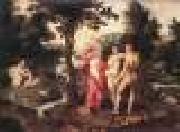 |
BACKER, Jacob de
|
|
Flemish painter (b. 1555/60, Antwerpen, d. 1585/90, Antwerpen)
Flemish painter and draughtsman. According to van Mander, as a young boy de Backer was abandoned by his father, also a painter, who had to flee Antwerp because of an impending court trial. Jacob then worked for several years in the studio of Antonio van Palermo (1503/13-before 1589) and later entered the workshop of Hendrick van Steenwijck. Van Mander further claimed that the strenuous labour that van Palermo had imposed on the young man had so wrecked his health that he died at the age of 30, in the arms of his former master's daughter. This, van Mander added, happened a long time ago, thus implying that de Backer died before van Steenwijck left Antwerp in 1586. This is confirmed by other evidence, including the age of van Palermo's daughter Lucretia, who was baptized in Antwerp on 25 July 1561. She lived until 1626 and at the time of her death still possessed six paintings by de Backer. |
|
|
|
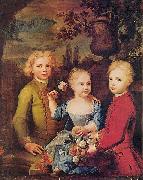 |
Balthasar Denner
|
|
(15 November 1685 in Altona - 14 April 1749 in Rostock) was a German painter, highly-regarded as a portraitist. He painted mostly half-length and head-and-shoulders portraits and a few group portraits of families in interiors. Usually Denner concentrated on the face; clothes and paraphernalia were done by other painters or later his daughter. |
|
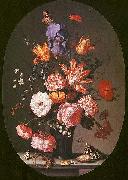 |
Balthasar van der Ast
|
|
(1593/94 - 1657) was a Dutch Golden Age painter who specialized in still lifes of flowers and fruit, as well as painting a number of remarkable shell still lifes; he is considered to be a pioneer in the genre of shell painting. His still lifes often contain insects and lizards. He was born in Middelburg and died at Delft.
|
|
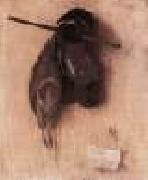 |
BARBARI, Jacopo de
|
|
Italian Early Renaissance Painter, ca.1440-1515
Italian painter and printmaker. He was the first Italian Renaissance artist of note who travelled to the courts of Germany and the Netherlands. His earliest known works appear to date from the late 1490s, suggesting that he was born c. 1460-70. The birthdate of c. 1440 traditionally assigned to him reflects the misinterpretation of a document of 1512 in which his patron, Margaret of Austria, Regent of the Netherlands, awarded him a stipend because of his 'weakness and old age'. In fact, at this date a man could be described as 'old' while in his fifties or even younger. |
|
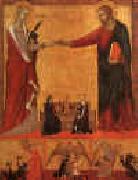 |
Barna da Siena
|
|
Italian Painter, active ca.1350
Barna da Siena, also known as Barna di Siena, was a Sienese painter active from about 1330 to 1350, and was the painter in Siena during this period. He learned his trade from Simone Martini. Barna is believed to have paint the frescoes depicting the life of Jesus in the Collegiata di San Gimignano and is generally credited with Christ Bearing the Cross, with a Dominican Friar in the Frick Collection in New York City. He was killed in a fall from the scaffolding. Barna's figures are more dramatic and vigorous than any in previous Sienese painting. |
|
|

